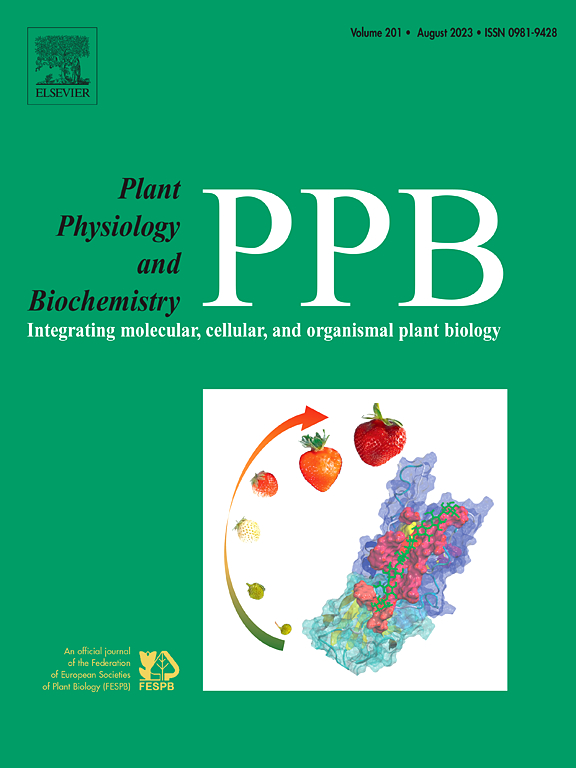Biophilic plant design: (Nano)Fertilising barley in hydroponics for ‘lush space gardens’
IF 6.1
2区 生物学
Q1 PLANT SCIENCES
引用次数: 0
Abstract
Plant growth in space goes beyond nutrition, it enhances well-being by connecting humans to nature through biophilic design. Nutrient stress is a major constrain in Space. This study used barley as a model plant in non-circulating hydroponics with varying nitrogen levels to simulate space nutrient stress conditions and test nano-fertiliser technology. Nitrogen-doped carbon quantum dots were applied in solution (hydroponics) and sprayed (aeroponics) to alleviate stress and keep the plant attractive under Space stress. The leaves' greenness was assessed using the soil plant analysis development (SPAD) during plant growth. The study found that plants grown under ‘high nitrogen’ (1 mM) conditions had higher SPAD and shoots-to-roots ratio (S/R) could reach as high as 31, and 3.2, respectively. In contrast, ‘low nitrogen’ grown plants were less green and bushy, wherein the SPAD and S/R were 11.2 and 1.03, respectively. The foliar fertilisation (FF) treatment turned out to be effective for the biophilic parameters, provided it started early, i.e. after one-week of plant growth. Applying an FF after two weeks was found to be less effective because the fresh S/R increased from 1.93 to 2.94. The FF treatment slightly increased the SPAD for the ‘low nitrogen’ sample by comparison to the control sample (no FF). Regardless of the treatment, the fresh shoot weight decreased under ‘low nitrogen’, except when being boosted by a high concentration (100 mg/l) of the nano-fertiliser quantum dots. Nonetheless, the fresh shoot weight of ‘low nitrogen’ growth was almost identical to ‘high nitrogen’ growth, which were 1.88 g and 2.20 g, respectively. These findings epitomise the potential of the nano fertiliser to reduce nitrogen use in plants. The results from the best experimental data gathered (greenness, shoots/roots, leaf number/shape) were implemented in a visualisation of an early-stage idea for the Spaceship interior using an artificial intelligence (AI) SDXL 1.0 model. Plant growth experiments in a home-built spacecraft replica confirmed that the use of LN (0.5 mM) conditions can be favourably used under ‘real-space conditions’ and that the nitrogen-doped carbon quantum dot nanofertiliser is effective for creating biophilic SPAD value.
亲生物植物设计:(纳米)在水培法中为“郁郁葱葱的太空花园”施肥大麦
植物在太空中的生长不仅仅是营养,它还通过亲生物设计将人类与自然联系起来,从而提高人类的福祉。营养压力是太空生活的主要制约因素。本研究以大麦为模式植物,在不同氮素水平的非循环水培条件下,模拟空间养分胁迫条件,试验纳米肥料技术。将氮掺杂碳量子点应用于溶液(水培)和喷雾(气培)中,以缓解胁迫,保持植物在空间胁迫下的吸引力。利用土壤植物分析发展(SPAD)对植物生长过程中叶片的绿度进行评价。研究发现,在“高氮”(1 mM)条件下生长的植株SPAD较高,茎根比(S/R)最高可达31和3.2。相比之下,低氮植株绿色和茂密程度较低,SPAD和S/R分别为11.2和1.03。叶面施肥(FF)处理被证明是有效的亲生物参数,只要它开始早,即在植物生长一周后。两周后施用FF的效果较差,因为新鲜S/R从1.93增加到2.94。与对照样品(无FF)相比,FF处理使“低氮”样品的SPAD略有增加。除了高浓度(100 mg/l)的纳米肥料量子点外,在“低氮”处理下,鲜梢重量都有所下降。然而,“低氮”生长与“高氮”生长的鲜梢重几乎相同,分别为1.88 g和2.20 g。这些发现集中体现了纳米肥料在减少植物氮肥使用方面的潜力。收集到的最佳实验数据(绿色、芽/根、叶数/形状)的结果使用人工智能(AI) SDXL 1.0模型实现了飞船内部早期想法的可视化。在自制的航天器上进行的植物生长实验证实,LN (0.5 mM)条件可以在“真实空间条件”下使用,并且氮掺杂碳量子点纳米肥料可以有效地产生亲生物的SPAD值。
本文章由计算机程序翻译,如有差异,请以英文原文为准。
求助全文
约1分钟内获得全文
求助全文
来源期刊
CiteScore
11.10
自引率
3.10%
发文量
410
审稿时长
33 days
期刊介绍:
Plant Physiology and Biochemistry publishes original theoretical, experimental and technical contributions in the various fields of plant physiology (biochemistry, physiology, structure, genetics, plant-microbe interactions, etc.) at diverse levels of integration (molecular, subcellular, cellular, organ, whole plant, environmental). Opinions expressed in the journal are the sole responsibility of the authors and publication does not imply the editors'' agreement.
Manuscripts describing molecular-genetic and/or gene expression data that are not integrated with biochemical analysis and/or actual measurements of plant physiological processes are not suitable for PPB. Also "Omics" studies (transcriptomics, proteomics, metabolomics, etc.) reporting descriptive analysis without an element of functional validation assays, will not be considered. Similarly, applied agronomic or phytochemical studies that generate no new, fundamental insights in plant physiological and/or biochemical processes are not suitable for publication in PPB.
Plant Physiology and Biochemistry publishes several types of articles: Reviews, Papers and Short Papers. Articles for Reviews are either invited by the editor or proposed by the authors for the editor''s prior agreement. Reviews should not exceed 40 typewritten pages and Short Papers no more than approximately 8 typewritten pages. The fundamental character of Plant Physiology and Biochemistry remains that of a journal for original results.

 求助内容:
求助内容: 应助结果提醒方式:
应助结果提醒方式:


